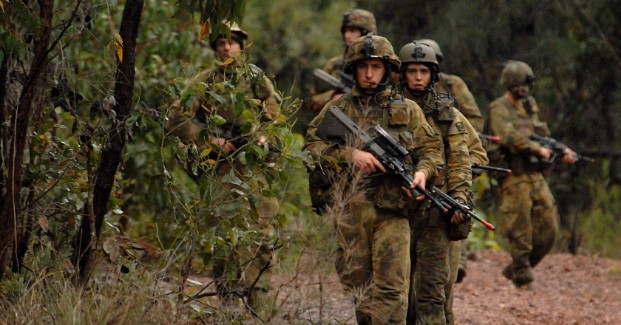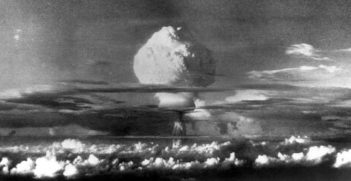When Should Australia Go To War?

In Australia’s bright and blessed circumstances today, we rarely think of war: it is something we go to, not something that comes to us. It seems we often shrink from talking about war in any detailed way, as if to speak of evil might set us on an inevitable path towards it. We have not yet begun to think through the choices that may confront us in years ahead and that’s problematic.
In the few moments when we publicly discuss or politically deliberate on new wars, our involvement in Iraq seems to set the template for our imagining of what war should or should not be. That’s problematic, because warfare is rapidly evolving and remains a possibility—particularly within our region.
Even among the most sceptical analysts, there is little doubt now that the actions of Chinese maritime agencies in the South China Sea are being tightly coordinated and endorsed by China’s leadership. These actions represent a more militarised, assertive strategy for the region, and confrontations between the United States and China now occur regularly. American warships heading into the South China Sea are hailed by Chinese naval warships, their intentions and their routes are questioned, and they are followed at a distance. The US Navy and other regional navies have responded by undertaking more freedom-of-navigation patrols, passages through the South China Sea designed to remind China of its obligations under the United Nations Convention on the Law of the Sea. These interactions are tightly choreographed and designed to make political points while demonstrating military restraint.
Similarly, China is being careful to keep any provocations and probing in “the grey zone”—not aggressive enough to cross the threshold and be considered acts of war, but certainly above the normal threshold of peacetime interaction. Yet operating military platforms at close proximity can be dangerous. In May 2016, US and Chinese aircraft had an encounter at less than 20 metres—the type of encounter that led to loss of life and an international crisis in 2001, when Chinese pilots attempted to force an American surveillance plane from its course to nearby Chinese territory.
Perhaps China only intends to undermine and embarrass the United States temporarily in the region or perhaps it intends much more. In Singapore, Malaysia, New Zealand, Vietnam and Indonesia, leaders have come to the conclusion that China intends to use its newly powerful military muscle to jostle and sometimes bully its way to what it wants. That means defence planners must think through the future implications of Chinese aggression happening in Japan, where the air force and navy are on heightened alert for intrusions into their territory by Chinese aircraft. It’s happening in the Philippines, where the US military has been invited back to operate for the first time since it was asked to leave Subic Bay in 1994. It’s happening in Vietnam, whose communist leader has tightened security and economic links with the United States.
Cheap access to commercial satellite technology means that China’s development of island fortresses is increasingly visible at the click of a mouse, but it remains hard for Australians to see the long-term significance of the granular developments in the South China Sea. According to a survey published by the United States Studies Centre this year, just four per cent of Australians rated the South China Sea as the most important national security threat to Australia—they were troubled instead by the more visible threat of terrorism.
But the potential for conflict in the South China Sea should be of concern. Beyond their immediate effect, any hostilities would involve massive disruption to the finely calibrated trade networks in East Asia that underpin the prosperity we take for granted and that our Asian neighbours have come to appreciate. Beyond the damage to our trading partners, there would be a direct impact on Australia’s economy were war to break out in the South China Sea: all our automotive gasoline comes from refineries in Taiwan, Korea and Singapore. All of this makes a major war in Asia one of the relatively low probability but with very high-impact risks that Australia cannot afford to ignore and needs to consider more seriously.
The 2016 Defence White Paper does not see major conflict in our region as likely but it clearly has made the judgment that such conflict is possible. That much is communicated by efforts to boost stocks and develop defence infrastructure in northern Australia. One example is particularly telling: hidden behind mountains in the upper Hunter Valley of New South Wales is a defence facility that stockpiles munitions for use in wartime: both the stockpile and the facility itself are being expanded. For years Australia has had bare bases in our north from which aircraft might operate, but never the fuel distribution systems to sustain them in the event of conflict. Now Defence plans to upgrade infrastructure and supply in those locations and in other places as remote as Australia’s Indian Ocean Cocos Island territory. Finally, although in past decades Defence has sought to maintain squadrons of advanced fighter jets to guard against regional threats, it has never developed the air defence systems in our northern cities necessary to support this. Now the latest defence white paper talks about the acquisition of radars and missiles that might contribute to an integrated air defence system across our skies.
The build-up of the Australian Defence Force is well underway; the government has backed up its judgment that war could be a possibility within the next two decades with many billions of dollars. But Australians have barely begun to think through the consequences of all this, nor thought seriously about the circumstances that might bring our nation to the point of conflict.
When should Australia go to war? The more we can think through the circumstances in which this question might arise, the less likely we will be to err in our calculations. Here are ten questions to be asked the next time our leaders want to commit Australian forces:
- Are our vital national interests threatened?
- Is there a clear political objective?
- Are our military aims linked to this political objective?
- Can the case be made to the Australian people that this campaign is in their interests, and can their support for the campaign be sustained through casualties and setbacks?
- Do we understand the costs—to the country, to civilian victims, to the enemy and to our veterans?
- What new dangers might this campaign cause?
- What proportion of the Australian Defence Force will it commit?
- What options will close to us if we take this action, and if we don’t?
- Will the Opposition remain committed, should it form government?
- How does this end?
James Brown is research director and adjunct professor at the US Studies Centre at the University of Sydney. This is an edited extract of Quarterly Essay 62, Firing Line: Australia’s Path to War and is republished with permission.





